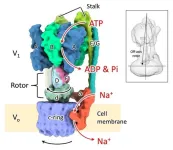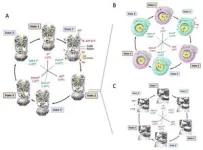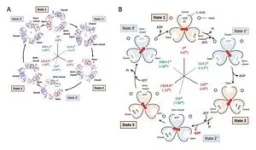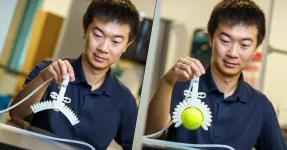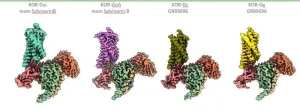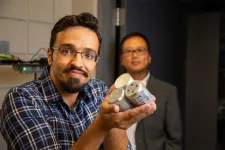(Press-News.org) Six structures exhibited by the rotating sodium ion pump were reconstructed in 3D using cryo-electron microscopy. This analysis revealed that (1) the rotor exhibits non-uniform rotation behavior due to partial structural interference with the stator component, and (2) the rotor interacts with one edge of the large ion transport ring causing it to rotate. The study showed a unique molecular mechanism of the rotary sodium ion pump.
The results will be published on July 28 in Communications Biology.
“In previous single-molecule imaging experiments, it was predicted that the three main pausing points of the rotor would be 120 degrees apart, and each sub-pause would be 40 degrees ahead (80 degrees back) from each main pause, but there was no structural evidence. It was also a mystery how the thin shaft (rotor) that connects the power unit rotates the sodium ion transport ring, which is larger than this unit.” said corresponding author Kazuyoshi Murata, project professor, Exploratory Research Center on Life and Living Systems (ExCELLS) and National Institute for Physiological Sciences (NIPS) in Japan. “The rotor turns the large ion transport ring as if it were stirring with uneven rotation behavior.”
・Research background
Almost all living organisms, from bacteria to humans, have the rotary enzyme ATP synthase, in their cell membranes. These all have a similar structure in which an extramembrane part for decomposing or synthesizing the compound ATP and an intramembrane part for passing ions across the membrane are connected by a thin shaft (rotor) to provide dual functionality. ATP synthase can use both the energy of the passive flow of ions across the membrane to synthesize ATP, while ions can be actively transported across the membrane by decomposing ATP.
The rotary sodium ion pump (EhV-ATPase) of Enterococcus hirae (Fig. 1) decomposes ATP in the extramembrane power unit (V1) and rotates the rotor at its center, which rotates the sodium ion transport ring (c-ring) of the intramembrane pump unit (Vo). This transports sodium ions from the inside to the outside of the cell. The power unit consists of three symmetrically arranged ATP degradation domains (consisting of an A/B heterodimer), which are known to rotate the rotor by 120 degrees through sequential degradation of ATP. Our research group previously labeled this power unit with a gold nanoparticle and performed single-molecule imaging experiments, and found that sub-pauses (State 1’ to 3’) exist at each position 40 degrees ahead (80 degrees back) of the main pauses (State 1 to 3), and identified six “pause” states. Also, EhV-ATPase has a large c-ring, like V-ATPase in higher organisms, but there is no other protein subunit that connects the rotator straight to the center of the c-ring, as seen in higher organisms. Therefore, in EhV-ATPase, (1) what the six structures including the sub-pause are, and (2) how the rotator rotates the large c-ring remained a mystery.
·Research result
In this study, in order to answer these questions, we induced rotation by adding ATP and sodium ions to detergent-solubilized EhV-ATPase, rapidly froze the sample, and collected many images using cryo-electron microscopy. After classifying the obtained images and reconstructing them in 3D, we succeeded in reconstructing a total of 6 structures consisted of 3 main pauses and 3 sub-pauses for the first time (Fig. 2A).
As described above, the rotor rotation of EhV-ATPase was supposed to stop at the main pausing points (States 1 to 3) separated 120°. This was true in States 1 and 2, but it was found that there was a -10° deviation in the rotor angle in State 3 (Fig. 2A). In addition, at the sub-pauses (State 1' to 3'), large angle deviations of +13° (State 1'), +32° (State 2'), and +28° (State 3') from those expected were observed. Then, it was found that the rotor edge deviated from the center of the c-ring and interacted to one edge of the c-ring, causing the c-ring to stir and rotate (Fig. 2B). This rotational angle deviation is particularly pronounced between States 2 and 3’, and it is thought that these are caused by structural interference between the subunit “d” of the rotor edge and the adjacent stator subunit “a” (Fig. 2C).
In the power unit V1, we were able to partially confirm changes in the bound and decomposed states of ATP during rotational motion (Fig. 3A). Based on previous studies, it is believed that the three symmetrically arranged ATP binding domains sequentially exhibit three states: “Closed” with ATP bound, “Semi-closed” with ATP decomposed into ADP and phosphate (Pi), and “Open” with no ATP or ADP bound. By applying these states to the obtained structural map, we were able to confirm the conformation of the ATP binding structure at the three main pauses. On the other hand, at the three sub-pauses, except for State 2', we obtained structures that are considered to be in a state in which all the ATP binding pockets are filled with ATP or ADP before ADP is released and the domain becomes "Open" (Fig. 3). As mentioned above, in State 2’, structural interference between the rotor and the stator was thought to cause the ATP binding domain to proceed to the same state as in State 3 and stop (Fig. 3B).
・Significance of results and future perspective
In this study, by actively inducing rotation and by analyzing the structures during rotor rotation, we were able to visualize six structures (three main pauses and three sub-pauses) of EhV-ATPase. This result clarified that the EhV-ATPase transports sodium ions by rotating a large c-ring and revealed that structural interference of the rotor with a part of the stator (subunit “a”) caused a deviation in the rotation angle. These findings suggest an adaptive process from a simple to a more complex structures in the evolution of the nearly ubiquitous rotary ion pumps, and have provided much structural information for the development of inhibitors and functional modification of enzymes. Based on this result, it is expected that drug discovery and development targeting this ion pump will progress greatly in the future.
END
The structures of six states of a rotary sodium ion pump are revealed
2023-07-28
ELSE PRESS RELEASES FROM THIS DATE:
New research highlights risks of selective adaptation in extreme coral habitats
2023-07-28
Resilient corals, often referred to as ‘super corals’, have recently been seen as potential saviours in the face of climate change and its detrimental effects on coral reefs.
Now, a team of scientists from the University of Technology Sydney (UTS) and the University of Haifa, Israel is working to better understand these corals in order to develop strategies to protect fragile ecosystems such as the Great Barrier Reef.
UTS scientist Dr Emma Camp, co-lead researcher on the study recently published in the journal Nature Communications, says the findings have significant implications ...
What nap times reveal about your child’s brain development
2023-07-28
Infants who nap a lot have smaller vocabularies and poorer cognitive skills – according to new research from the University of East Anglia.
Parents the world over are prone to worry about their children getting either too little or too much sleep.
But a new study published today reveals that some children are more efficient at consolidating information during sleep, so they nap less frequently.
Meanwhile others, usually those with fewer words and poorer cognitive skills, need to nap more frequently.
The research team say that reducing naps for these children will not improve brain development, ...
Activewear angst: Why shopping for workout clothes can be harmful to women
2023-07-28
Though it’s just as likely to be worn while lounging on the couch as in the gym, a large driver of activewear’s popularity among women is its association with a dynamic lifestyle, positive wellbeing and overall good health.
However, two new Edith Cowan University (ECU) studies suggest online shopping for activewear may in fact be harmful to women’s body image.
Sales of “Athleisure” — a hybrid style of athletic clothing typically worn as everyday wear — have risen rapidly following ...
This 3D printed gripper doesn’t need electronics to function
2023-07-28
This soft robotic gripper is not only 3D printed in one print, it also doesn’t need any electronics to work.
The device was developed by a team of roboticists at the University of California San Diego, in collaboration with researchers at the BASF corporation, who detailed their work in a recent issue of Science Robotics.
The researchers wanted to design a soft gripper that would be ready to use right as it comes off the 3D printer, equipped with built in gravity and touch sensors. As a result, the gripper can pick up, hold, and release objects. No such gripper existed before this work.
“We ...
Structure of opioid receptors may reveal how to better design pain relievers, addiction therapies
2023-07-28
Opioids remain the most potent and effective pain relievers in medicine, but they’re also among the most addictive drugs that can halt a person’s ability to breathe during an overdose — which can be deadly. Researchers have been racing to develop safer pain reliever drugs that target a specific opioid receptor, called the kappa opioid receptor, that is only found in the central nervous system and not elsewhere in the body, like other opioid receptors. Previous research suggests that such drugs may not lead to addiction or death due to overdose, but ...
Osivax announces publication in The Lancet Infectious Diseases of Phase 2a data for broad-spectrum influenza vaccine candidate, OVX836
2023-07-28
OVX836 demonstrated positive safety and immunogenicity data across three dose levels
A notable signal of protection of 84% was observed against symptomatic influenza infection
Lyon, France – July 28, 2023 – Osivax, a biopharmaceutical company developing vaccines to provide broad-spectrum protection against highly mutating infectious viruses, today announced that The Lancet Infectious Diseases published results from the company’s OVX836-003 study under the title, “Immunogenicity, safety and preliminary efficacy evaluation of OVX836, a nucleoprotein-based universal influenza A vaccine candidate: randomised, double-blind placebo-controlled, Phase 2a trial.” ...
Study reveals vital role of supportive managers to minimize physical restraint use in care homes
2023-07-28
A new Cochrane review finds that the use of physical restraints on care home residents can be reduced without increasing the risk of falls, when frontline care staff are empowered by supportive managers.
Physical restraints are devices that restrict freedom of movement and are frequently used in residential care homes, such as nursing homes and assisted living facilities. Examples are bed rails or belts that prevent residents from getting out of bed unassisted. These restraints are ethically problematic as they are mostly ...
Yelp reviews of plastic surgeons – what factors affect positive and negative ratings?
2023-07-27
July 27, 2023 – How many stars would you give your plastic surgeon? An analysis of Yelp reviews identifies a wide range of surgeon-and practice-related factors that influence whether plastic surgery patients leave positive or negative reviews, reports the September issue of Plastic and Reconstructive Surgery®, the official medical journal of the American Society of Plastic Surgeons (ASPS). The journal is published in the Lippincott portfolio by Wolters Kluwer.
"Our study also identifies some sources ...
FAMU-FSU researchers advance electric vehicle battery safety with new energy absorption design
2023-07-27
Researchers at the FAMU-FSU College of Engineering are improving the safety and performance of electric vehicles through a new design that protects their batteries.
Their design uses tubes filled with paraffin wax, which is a type of phase change material, or PCM. These materials are commonly used to store and dissipate heat, making them useful for protecting a battery from overheating.
The researchers’ new method uses PCM-filled tubes in another way, exploring their application as protection against ...
New manufacturing equipment could be used at sea or in deep space
2023-07-27
An industrial engineering researcher at The University of Texas at Arlington has earned a grant from the Department of Defense to purchase state-of-the-art hybrid additive-subtractive manufacturing equipment.
The project will improve manufacturing capabilities at UTA for printing a wide range of metals and alloys. The grant recipient, Emma Yang, is an assistant professor in the Industrial, Manufacturing, and Systems Engineering Department and an expert in additive and sustainable manufacturing. END ...
